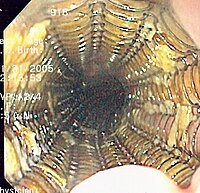
Photo from wikipedia
Background Palliative therapies for malignant biliary obstruction (MBO) include choledochojejunostomy and self-expanding metallic stent (SEMS) insertion. Fractures following SEMS insertion in MBO treatment are scarce. Objective To assess the clinical… Click to show full abstract
Background Palliative therapies for malignant biliary obstruction (MBO) include choledochojejunostomy and self-expanding metallic stent (SEMS) insertion. Fractures following SEMS insertion in MBO treatment are scarce. Objective To assess the clinical features of biliary stent fractures and evaluate associated factors. Methods One hundred fifty-six consecutive patients who underwent biliary SEMS placement for MBO treatment at Beijing Chaoyang Hospital affiliated to Capital Medical University, in 2010–2015, were evaluated retrospectively. Demographics, clinical features, stent parameters and patency times, and survival times were collected. Across the ampulla of Vater, balloon dilatation, number of stents, stent patency time, and survival time were compared between the stent and nonstent fracture groups. Results There were 168 biliary metallic stents inserted in 156 patients, including 144 and 12 patients with one and 2-3 stents, respectively. Pre- and/or postballoon dilation was performed in 107 patients. Stents across and above the duodenal papilla were used in 105 and 51 patients, respectively. Six cases (3.8%) with stent occlusion had stent fractures. Single- and multiple-stent fracture rates were 4/144 (2.8%) and 2/12 (16.7%), respectively. Fracture times after stent deployment were 126.8 ± 79.0 (median, 115.5) days. Stent patency times in the stent and nonstent fracture groups were 151.8 ± 67.8 (median, 160.5) days and 159.3 ± 73.6 (median, 165.5) days, respectively. Overall survival times in the stent and nonstent fracture groups were 399.7 ± 147.6 (median, 364.0) days and 283.7 ± 126.1 (median, 289.0) days, respectively. Conclusion Stent fractures following MBO treatment constitute a relatively rare long-term complication. Though there were no factors found to be significantly associated with SEMSs fracture, a trend could be observed towards more fractures in multistent, transpapillary, and balloon dilation groups.
Journal Title: Gastroenterology Research and Practice
Year Published: 2018
Link to full text (if available)
Share on Social Media: Sign Up to like & get
recommendations!